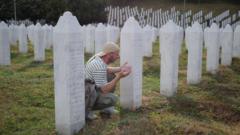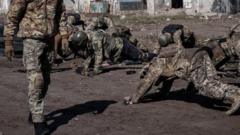What Lasting Impact Does the Srebrenica Massacre Have 30 Years Later?

Understanding the Srebrenica Massacre: A Dark Chapter in European History
The Srebrenica massacre of July 1995 stands as one of the most harrowing events in recent European history. This atrocity is not just a footnote in the annals of the Bosnian War; it is a stark reminder of the consequences of hatred, division, and the failure of international intervention. The recent world premiere of *Flowers of Srebrenica* at Sarajevo's War Theatre brings this painful legacy into focus, inviting audiences to confront the unresolved grief and ongoing divisions that continue to plague Bosnia and Herzegovina decades after the tragedy. This article delves into the historical context, the massacre itself, the aftermath, and the current socio-political landscape in Bosnia and Herzegovina, exploring how the shadows of the past still loom large over the present.
The Historical Context of the Bosnian War
To understand the Srebrenica massacre, it is essential to grasp the broader historical context of the Bosnian War, which erupted in 1992 following the disintegration of Yugoslavia. Ethnic tensions that had simmered for decades were exacerbated by nationalist rhetoric, leading to a brutal conflict that pitted Bosniaks, Croats, and Serbs against one another.
The war was marked by horrific acts of violence, including ethnic cleansing, mass rapes, and systematic killings. The international community's response was tepid at best, with the United Nations declaring certain enclaves, including Srebrenica, as "safe areas." However, this designation proved to be tragically ineffective.
The Siege of Srebrenica
Srebrenica, a small town in eastern Bosnia, became a refuge for thousands of Bosniaks fleeing the violence. Believing they were under the protection of the United Nations, around 20,000 people sought shelter within its borders. The town was ostensibly safeguarded by Dutch peacekeepers, but their presence did little to deter the advancing Bosnian-Serb forces led by General Ratko Mladić.
On July 11, 1995, the Bosnian-Serb army overran Srebrenica. In an act that would be condemned worldwide, they separated men and boys from women and children, gathering approximately 8,000 individuals who were subsequently executed in a systematic campaign of genocide. This event remains the most significant war crime committed in Europe since World War II.
The Role of International Forces
The United Nations' failure to protect the civilians in Srebrenica raises critical questions about accountability and the responsibilities of international peacekeeping forces. The Dutch soldiers stationed there were instructed to prioritize their safety, which ultimately led to their inaction as the massacre unfolded. The betrayal felt by the survivors and the families of victims is palpable, compounded by the disbelief that such a tragedy could occur under the watch of the international community.
The Aftermath: Unraveling the Trauma
The aftermath of the Srebrenica massacre left deep scars on the collective psyche of Bosnia and Herzegovina. The systematic burial of victims’ bodies in mass graves, followed by the subsequent exhumation and reburial in multiple sites, further complicated the mourning process for families. Many are still searching for their loved ones, relying on DNA testing to provide closure.
The *Potočari Cemetery*, located adjacent to the former UN base, has become a significant site of remembrance, where families gather to honor the victims. The act of remembering is vital, as it allows the survivors to confront their past while striving for justice and recognition.
Genocide Denial and Political Divisions
Despite the irrefutable evidence and the convictions of key figures like Ratko Mladić and Radovan Karadžić, genocide denial remains rampant, particularly in the majority-Serb entity of Republika Srpska. Political leaders in this region frequently downplay or outright deny the genocide, claiming that the narrative is used to deepen divisions rather than foster reconciliation.
Selma Alispahić, the lead actress in *Flowers of Srebrenica*, articulates a sentiment shared by many: the persistent denial of the facts surrounding the genocide only serves those who profit from the ongoing divisions. The political landscape remains fractured, with the Dayton Peace Agreement establishing two distinct entities based on ethnic lines, further entrenching divisions.
The Contemporary Socio-Political Landscape
Today, Bosnia and Herzegovina is still grappling with the legacy of the war. The political structure, shaped by the Dayton Agreement, creates a complex web of governance that often hinders unity. The Federation of Bosnia and Herzegovina is predominantly inhabited by Bosniaks and Croats, while Republika Srpska is home to the majority of Serbs.
Current Political Tensions
In recent months, tensions have escalated in Republika Srpska under the leadership of Milorad Dodik, who has sought to withdraw from national institutions and has challenged the authority of the international High Representative. His actions and rhetoric echo the divisive sentiments that fueled the war, leaving many citizens, especially those from the Bosniak community, feeling vulnerable and unprotected.
International representatives like Christian Schmidt, the current High Representative, have expressed concern over the actions of Dodik and the potential for renewed conflict. The establishment of a "reserve police force" has raised alarm bells, as the terminology used harkens back to the violent militias of the 1990s.
The Significance of Commemoration and Solidarity
Amidst the political turmoil, the importance of commemoration and solidarity cannot be overstated. Events like the annual Srebrenica memorial serve as a beacon of hope, drawing thousands from across the country to pay their respects and honor the victims. These gatherings embody a collective commitment to remembering the past and striving for a more unified future.
Notably, while Sarajevo openly commemorates the victims, there is a stark contrast in Republika Srpska, where public references to the massacre are minimal. This dichotomy illustrates the ongoing divisions that persist in the country, underscoring the need for a concerted effort toward reconciliation.
Community Resilience and the Path Forward
Despite the challenges, many individuals and organizations are dedicated to fostering understanding and healing. Grassroots movements, supported by citizens from various ethnic backgrounds, emphasize the importance of collective memory and the need for accountability for all crimes committed during the war. They seek to bridge the divides that have been artificially sustained by political leaders.
Mirela Osmanović, whose family suffered losses during the massacre, reflects the resilience of those working to create a more inclusive environment. Her experience highlights the need for a supportive community as Bosniaks return to the areas where their loved ones were killed. The memories of the past are a powerful motivator for many to ensure that history does not repeat itself.
Conclusion: Reflecting on the Past, Shaping the Future
The legacy of the Srebrenica massacre continues to shape the socio-political landscape of Bosnia and Herzegovina. While the wounds of the past may never fully heal, the importance of remembrance and reconciliation is paramount. The ongoing struggles against genocide denial and political manipulation remind us that the fight for truth and justice is far from over.
As we reflect on the events of July 1995, it is imperative to question how we can contribute to a future that honors the victims while fostering peace and understanding among all communities in Bosnia and Herzegovina. The path to healing may be fraught with challenges, but it is a journey that must be undertaken if the lessons of the past are to inform a better tomorrow.
Frequently Asked Questions (FAQs)
What was the Srebrenica massacre?
The Srebrenica massacre refers to the systematic killing of around 8,000 Bosniak men and boys by Bosnian-Serb forces in July 1995 during the Bosnian War. It is considered the most significant war crime in Europe since World War II.
Why is the Srebrenica massacre significant today?
The Srebrenica massacre remains a critical symbol of the consequences of ethnic hatred and divisions. It serves as a reminder of the need for accountability and reconciliation in post-conflict societies.
How do political divisions affect Bosnia and Herzegovina today?
The political divisions established by the Dayton Peace Agreement continue to hinder national unity and reconciliation efforts. Leaders in different entities often promote narratives that deepen ethnic tensions, complicating efforts for a cohesive society.
Reflecting on the past can be painful, but it is essential for shaping a future free from the shadows of hatred. How can we contribute to healing and understanding in divided societies? #Srebrenica #BosnianWar #Reconciliation
Published: 2025-07-11 03:51:13 | Category: world



